



You probably reached this "Blog5" page from that called
GPS Guided Trans-Atlantic Robot Boat,
or the
Design of Snoopy Sloop page
.
If not, click on a link to know more.
Each "blog" page describes detailed work preparing for the next Atlantic Attempt.
i.e. covering a period in the region of a year: less if more than one attempt is made.
The Blog pages were started after the first 2012 Attempt, where Snoopy's boat was lost. All later attempts were
with the same boat, sometimes after major repairs. The blogs provide online "Engineering Notebooks",
providing a day-by-day account of repairs, changes, and testing: mostly testing.
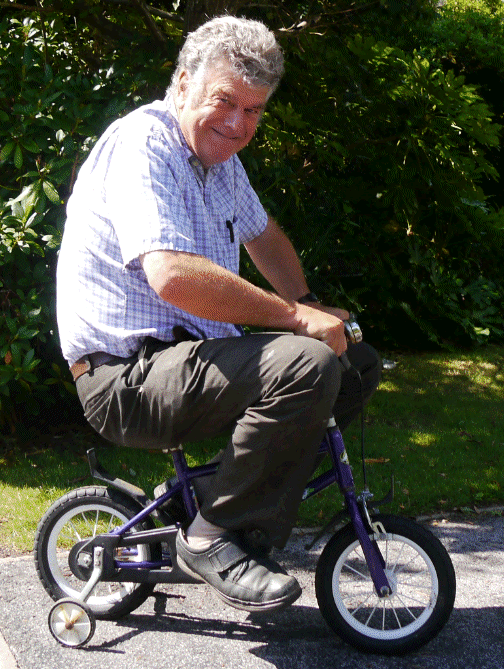
 These blog pages are mostly about numerous repairs to the boat, results from "BRAY LAKE TEsts", or 24/7 reliability testing on Bray Lake.
i.s. Snoopy sailing back and forth over a 24/7 waypoint in "Snoopy Corner". This is typically for several weeks,
in all weather, including gale force winds.
Sometimes, a few things happened which resulted in amusing pictures or stories,
such as countering human-intervention, or testing the wheels for Snoopy's trolly.
Click on the pictures either side for larger versions, or visit earlier blogs above.
BlogX, the "blog of experiments", shows ideas and products, some of which may appear
in future boats.
These blog pages are mostly about numerous repairs to the boat, results from "BRAY LAKE TEsts", or 24/7 reliability testing on Bray Lake.
i.s. Snoopy sailing back and forth over a 24/7 waypoint in "Snoopy Corner". This is typically for several weeks,
in all weather, including gale force winds.
Sometimes, a few things happened which resulted in amusing pictures or stories,
such as countering human-intervention, or testing the wheels for Snoopy's trolly.
Click on the pictures either side for larger versions, or visit earlier blogs above.
BlogX, the "blog of experiments", shows ideas and products, some of which may appear
in future boats.
This is a record of repairs and changes made to the boat, after the March 2015 Atlantic Attempt. See Blog1, Blog2, Blog3 and Blog4 pages, for earlier progress.
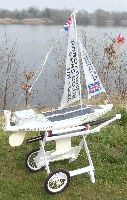
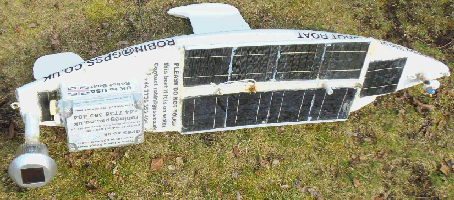 Tuesday 17th March:
Snoopy's Atlantic attempt could be* as early as tomorrow, so he was brought home to make sure he is ready.
No need for a rescue by the club house boat, because snoopy had drifted, in no wind, to a convenient position
in the south-west corner of the lake. Just a matter of using the pole and then the trolly.
Tuesday 17th March:
Snoopy's Atlantic attempt could be* as early as tomorrow, so he was brought home to make sure he is ready.
No need for a rescue by the club house boat, because snoopy had drifted, in no wind, to a convenient position
in the south-west corner of the lake. Just a matter of using the pole and then the trolly.
At home, the hull was laid to catch an hour or two of sun, with the autopilot switched off.
The B&Q lamp was added easily, at the back, and so was the I-GotU GPS Logger, now switched on and inside the box at the back.
Some of the "muck" was wiped off the hull, particularly near the labels, which seemed to have faded.
A marker pen was used to make the text a little more legible.
Power was OK at 1530: 5v (4.91,5.54->5.31v) SPOT 3.72v.
* Launch was at 1100 in morning, Wednesday 18th March, west of Boscombe Pier.


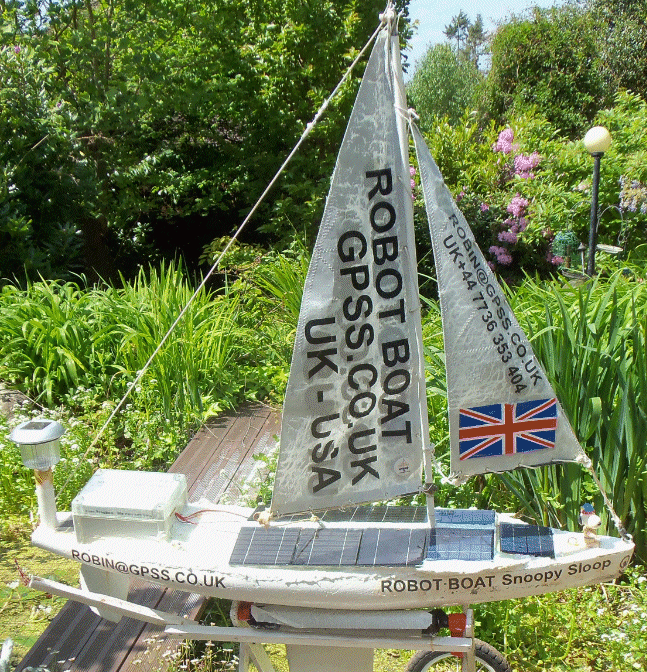
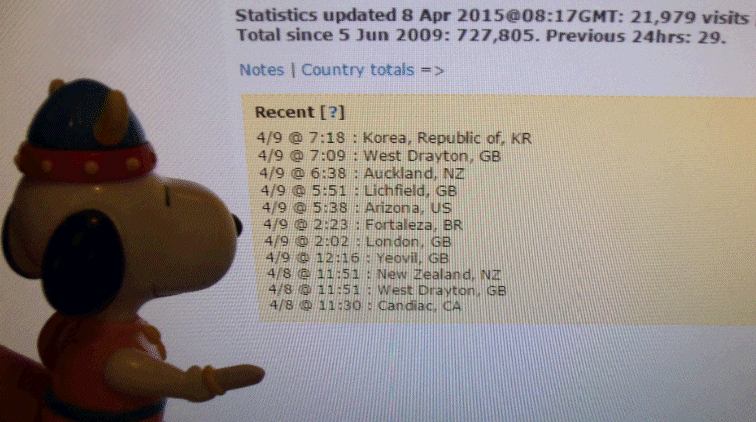 see
Snoopy's March 2015 Atlantic Attempt, to see what happened in more detail.
see
Snoopy's March 2015 Atlantic Attempt, to see what happened in more detail.
Wednesday 20th May 2015:
"Work" is proceeding at a relaxed pace, towards another attempt this year, probably in August or September.
A glance at the solar panel voltages earlier shows that the LHS of the duplicated solar power was probably
already suspect ! All those panels have now been replaced.
The Picaxe timer, controling the SPOT tracker has been changed to "press" [OK] every 20 minutes,
instead of every hour, and you can see the updates on the
SPOT3 Map.
Thursday 21st May:
Click on the picture of the boat, for a bigger version.
Voltages are now typically Main 5v: 5.62,5.59->5.3v Spot: 3.94v.
What's Snoopy looking at, on the right ? He's watching those watching GPSS.co.uk - not the usual pattern of "hits" :-)
Wednesday 27th May: Yes, we are off in a few hours by Easyjet, for another two weeks in Sicily. For those few interested in who was watching www.gpss.co.uk in the days leading up to, and including, the March attempt, this link from Marc of Clustrmaps.com, used for those hits shown on the Homepage, is here: Majestic.com reports for www.gpss.co.uk. After we got back 2 weeks later ... Click on the "Holiday" link at top of most of Robin's pages, for pictures and video of the holiday.
Friday 17th July:
After a few weeks indoors, near the patio door, and not getting enough light for the solar panels,
the batteries ran low enough for the SPOT tracker to start missing reports.
These soon recharged, after putting the boat outside, to catch more light, and SPOT3 transmissions are every 20 minutes.
The autopilot was switched on at 1745 yesterday (16th), and main 5v power at 2100 was (5.38,5.39->5.14v).
The autopilot ran all night, and at 0715 today was (5.08,5.09->4.83v).
Note that the rudder servo has NOT been replaced, since the March 2015 attempt.
The earlier
Blog4
shows this last being done on 13th December 2014.
BlogX shows servo reliability tests (to destruction)
indicating that the typical working life is in the ballpark of only 2 or 3 months.
[ CORRECTION ON 3rd AUGUST: SERVO RELIABILITY IS PROBABLY MUCH BETTER: SEE BLOGX ]
Sunday 19th July:
The servo was replaced by a spare, already sealed with sealant. By coincidence(?), when
I switched off, then on, the autopilot, that had been operating, the existing servo failed.
This is now labelled "March 2015 attempt" and joins the others, tested to destruction.
The boat, with autopilot operating the rudder, was put outside at 1335, to resume
24/7 testing of the total boat system. I adjusted the rudder absolutely central,
moving the linkage, then re-applying blue loctite. A Bray Lake test will be needed, along with a few days of 24/7 testing
- but not TOO many, that could reduce the life of the servo.
Tuesday 21st July:
The autopilot was switched off at 1600, to reduce risk of wearing the servo out.
The boat was kept outside, but a shadier spot, to reduce risk of over-charging batteries.
Main 5v power was (5.63,5.67->5.41v).
Monday 31st August:
The boat was moved to a less shadier position, after the SPOT was seen to be missing it's usual 3 reports/hour.
Stopped at 2322 and did not start until 0926. Main 5v power was 5.52,5.52 but SPOT 3.6 power was 3.16v.
Weather has been overcast and rainy, and SPOT solar panel was hidden by vegetation.
Thursday 3rd September: See BlogX : Servo reliability is probably much better than we had previously estimated. The less shadier position means the SPOT solar power is gradually recovering. SPOT reports still slow down overnight, but manage at least one or two per hour. By mid morning, the correct 3 per hour is achieved. The spare SPOT4, in a sunnier position, continues to give accurately timed reports, every 20 minutes, and has done so for months.
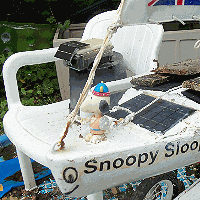 Tuesday 8th September:
The two servos on 24/7 test are still OK. The boat, with it's SPOT3 tracker, was moved at 10am to the same,
most sunny position, near SPOT4, that has run for months, with well-timed reports every 20 minutes.
It probably is also a better position for GPS signals and SPOT communications.
This was after over a week, since SPOT3 failed to get enough light to fully recover at night.
i.e. the 3 reports per hour tended to drop to 1 or 2 in the early hours.
SPOT3 power typically dropped to 3.43v, below the desired 3.6v.
Now SPOT3 and SPOT4 are being tested under the same conditions.
Some scraps of wood were used to partly shield the main 5v supply solar panels,
so we need not worry about over charging. The autopilot remains switched off.
Tuesday 8th September:
The two servos on 24/7 test are still OK. The boat, with it's SPOT3 tracker, was moved at 10am to the same,
most sunny position, near SPOT4, that has run for months, with well-timed reports every 20 minutes.
It probably is also a better position for GPS signals and SPOT communications.
This was after over a week, since SPOT3 failed to get enough light to fully recover at night.
i.e. the 3 reports per hour tended to drop to 1 or 2 in the early hours.
SPOT3 power typically dropped to 3.43v, below the desired 3.6v.
Now SPOT3 and SPOT4 are being tested under the same conditions.
Some scraps of wood were used to partly shield the main 5v supply solar panels,
so we need not worry about over charging. The autopilot remains switched off.
Thursday 10th September:
The better position in the garden means that the SPOT3 power has recovered, so that 3/hour SPOT reports remain
accurately timed overnight: currently on the hour, 20 and 40 minutes past - within a minute or two.
Only two reports were missed - at 0440 and 0640 - but that can be put down to the SPOT service, since later timing was accurate.
You can see lates SPOT3 reports
here,
and those for SPOT4, which has been running months,
here.
 Friday 11th September 2015:
The autopilot was switched on, to see how well the main 5v power stays up, now Snoopy is in a sunnier position.
We can also be more relaxed about the risk of "wearing the servo out" with our new servo reliability info on
BlogX. At 0915 main power was 5.2v falling to 5.16v at 0945 still in shade.
The SPOT is doing well, keeping good timing overnight, with voltage climbing from 3.5v @ 0915 to 3.63v @ 0945.
Friday 11th September 2015:
The autopilot was switched on, to see how well the main 5v power stays up, now Snoopy is in a sunnier position.
We can also be more relaxed about the risk of "wearing the servo out" with our new servo reliability info on
BlogX. At 0915 main power was 5.2v falling to 5.16v at 0945 still in shade.
The SPOT is doing well, keeping good timing overnight, with voltage climbing from 3.5v @ 0915 to 3.63v @ 0945.
Wednesday 16th September:
Autopilot still OK. 5v power only drops to typically 4.69v and SPOT to 3.57v @ 0715. SPOT timing good. Power up to typically 5.07/3.73v @1700.
Friday 18th September:
The autopilot was switched off at 0915, after 7 days of continuous operation. The solar power coped well, including after overcast days.
At 0725 power was 4.71v/3.58v and at 0915, was 4.74v/3.63v. SPOT timing remained accurate and reliable.
Both servos are still running, on indoor 24/7 test, started on 3rd September, and reported in
BlogX.
Monday 28th September 2015:
Both servos on 24/7 test still good after 25 days. Both SPOT trackers still good, reporting every 20 minutes, on
SPOT3
and
SPOT4
.
Wednesday 25th November:
I noticed that the smaller Hitec HS-5086WP servo had stopped.
BlogX
shows 24/7 test started on 3rd September, so this product failed after 11 weeks (< 3 months MTBF).
However, the trusty Acomms AS-17 servo is still running, confirming that we should stick to this product,
until a better product is proven.
SPOT3 (in the boat) continues to run, sometimes slowing overnight to maybe one or two transmissions per hour,
particularly after several overcast days. However, by mid morning, SPOT3 is normally back to accurate 20 minute reports.
SPOT4 is similar, but slower to recover, due to less solar panel area.
27 December 2015:SERVO FAILS ! The Acoms AS1-17 servo failed, in a hot condition yesterday.
We can do the arithmetic in slower time :-)
Snoopy is ready for another Atlantic Attempt, but this can wait until 2016. Our main reason for failure in March 2015 was almost certainly "build quality". i.e. we had hidden solar panel wiring corrosion building up from previous attempts. This "GPS only" design seems reliable, and our only "design change" is the faster rate of SPOT reporting, well tested already. I quite like the "natural compensation" within our autopilot design, such that we can see the autopilot is working, by the fact that the track is directly towards the next waypoint - when sailing speed is faster than the tidal current ! We will keep Boat11 in reserve, as a "toy", until we get the results from our next attempt in 2016.
2016: Monday 29th February:
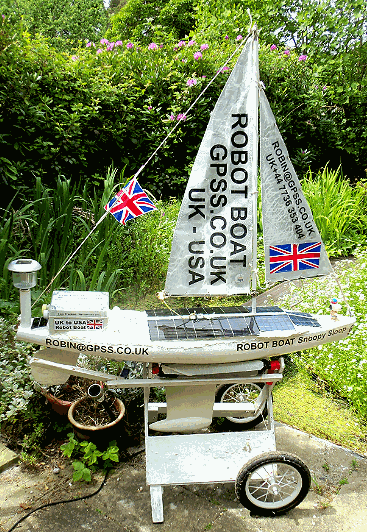 The autopilot was switched ON at 1020, so we could check everything still works,
and how well the solar power stays up, now that the days are getting longer.
We don't want to leave the autopilit on for too many weeks,
since the servo will eventually wear out: best if it lasts at least
a few weeks at sea !
Both duplicated power switches worked OK, with the rudder doing it's corrrect left-right-centre
startup, followed by random movements every few seconds, after the GPS starts tracking.
Main duplicated 5v power was (6.03,5.16)->5.72v. SPOT was 3.91v.
At 1355 this was (5.72,5.51)->5.45v. SPOT was 3.91v. Still bright and sunny, to charge the batteries.
The autopilot was switched ON at 1020, so we could check everything still works,
and how well the solar power stays up, now that the days are getting longer.
We don't want to leave the autopilit on for too many weeks,
since the servo will eventually wear out: best if it lasts at least
a few weeks at sea !
Both duplicated power switches worked OK, with the rudder doing it's corrrect left-right-centre
startup, followed by random movements every few seconds, after the GPS starts tracking.
Main duplicated 5v power was (6.03,5.16)->5.72v. SPOT was 3.91v.
At 1355 this was (5.72,5.51)->5.45v. SPOT was 3.91v. Still bright and sunny, to charge the batteries.
SPOT3 (in boat) is still good, reporting every 20 minutes, on
SPOT3
and
SPOT4 (spare)
misses some at night, due to smaller solar panels.
Tuesday 1st March:
Autopilot still running with power, at 0850 being
(5.05,5.01)->4.78v; SPOT 3.59v. Cloudy.
Wednesday 2nd March:
Ditto, at 0720 being
(4.8,4.81)->4.53v; SPOT 3.55v. Cloudy. SPOT3 reports still every 20 minutes all night.
Thursday 3rd March:
Ditto, at 0715 being (4.45,4.51)->4.17v. SPOT 3.54. Clear sky. SPOT3 still good.
Ditto, at 1350 being (5.45,5.45)->5.20v. SPOT 3.81v. Bright sun. ditto.
Friday 4th March:
0730: Autopilot stopped with 1Hz rudder twitch. 5v Power low: (3.5,3.5)->3.25v. SPOT 3.56v. Clear sky.
We will see if autopilot restarts OK as sun comes up... Yes: OK sometime between 0920 and 1025: (5.35,5.04)->5.07v.
Imbalance to be expected, because more sun on LHS. SPOT 3.61v. No SPOT3 delays or losses all night.
Sunday 6th March:
Yesterday Autopilot was still running at 0730. 5v power was (4.9,4.9)->4.63v. But the day was cloudy,
and this morning, by 0720, the Autopilot had stopped completely. Power was (3.44,3.31)->3.17v. SPOT 3.57v.
Sky clear, and covered with frost, but that will soon melt. Autopilot expected to restart later
this morning.
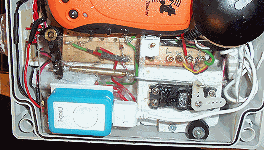 FAILURE noticed at 1045. The rudder was frozen central, despite enough sun on the solar panels.
Voltage check confirmed enough 5v power: (5.27,5.13)->5.01v. Duplicated power switch, normally off,
did not help when switched on. Reboot fixed it, by switching OFF then ON. Conclusion: should not
happen often, particularly as days get longer, but automatic restart on power recovery is not 100% reliable.
FAILURE noticed at 1045. The rudder was frozen central, despite enough sun on the solar panels.
Voltage check confirmed enough 5v power: (5.27,5.13)->5.01v. Duplicated power switch, normally off,
did not help when switched on. Reboot fixed it, by switching OFF then ON. Conclusion: should not
happen often, particularly as days get longer, but automatic restart on power recovery is not 100% reliable.
Monday 7th March:
5v power had dropped again overnight, giving a 1Hz twitch. 0940: (3.5,3.5)->3.24v. SPOT 3.62v.
This spot, near June's pool, does not get the sun until late morning, due to the house,
so the boat was moved into a sunnier position, to catch the sun. The Autopilot started immediately,
and 5v rose to (5.02,4.95)->4.76v. SPOT 3.67v. The lid was taken off, to reveal condensation, including
a lot on the I-GotU. However, taking the I-GotU indoors, and unloading the data with @TripPC,
showed that it was still working. It had collected 38460 points (~320 days) since 20th July 2015,
up until this test. @TripPC was used to clear data and check that parameters were correct:
Every 12 minutes (720 secs), power saving, not smart tracking, circular logging.
I declined the offer of a software "upgrade" to @TripPC, since it already worked ;-)
The I'GotU was put back in the boat, with autopilot still running, in the sun, at 1040.
Tuesday 8th March:AUTOPILOT SWITCHED OFF at 0835. 5v at (4.74,4.7)->4.43v.
Earlier, at 0715 the AP was still running, and at 0725 5v was (4.68,4.7)->4.35v.
AP solar panels were covered with scraps of wood to prevent over-charging.
Conclusion: after nearly 8 days of running, the Autopilot and it's 5v power system seems as would
be expected, and OK.

 Saturday 23rd April:
Following is from "Experimental Blog"
BlogX : "...
Saturday 23rd April: BETTER JIB SHAPE AFTER SEEING BOAT 12's 15.5 MINUTE BRAY LAKE TEST ?
... I may make a minor change on the current Boat 10, waiting for the Atlantic Attempt, on where the jib is tied.
It's a minor change and a good excuse to remind myself if the boat can still be put in the car,
for the required Bray Lake Test. e.g. if those rusty quick links still enable the rig to be removed !".
This was after the fantastic fast circuit of Bray Lake by Eric's IOM boat 12 in just 15.5 minutes.
Check out the video of last Wednesday and Thursday's Bray Lake Tests on the
Boat 12 Blog
page. With the jib tied at the front, we got the same slow progress upwind as experienced by all out boats
for years. This picture on the left is Boat 12 on Wednesday.
With the jib tied at the boom, on Thursday, we got much better tacking. It looked like a better jib sail shape,
with less jib flutter when sailing close to the wind. i.e. the "luff", or trailing edge of the jib, is closer to
the mast. With the jib tied at the front, the jib boom tends to rise at the back, allowing the luff to curve
away from the mast and mainsail, as in this Wednesday picture.
Saturday 23rd April:
Following is from "Experimental Blog"
BlogX : "...
Saturday 23rd April: BETTER JIB SHAPE AFTER SEEING BOAT 12's 15.5 MINUTE BRAY LAKE TEST ?
... I may make a minor change on the current Boat 10, waiting for the Atlantic Attempt, on where the jib is tied.
It's a minor change and a good excuse to remind myself if the boat can still be put in the car,
for the required Bray Lake Test. e.g. if those rusty quick links still enable the rig to be removed !".
This was after the fantastic fast circuit of Bray Lake by Eric's IOM boat 12 in just 15.5 minutes.
Check out the video of last Wednesday and Thursday's Bray Lake Tests on the
Boat 12 Blog
page. With the jib tied at the front, we got the same slow progress upwind as experienced by all out boats
for years. This picture on the left is Boat 12 on Wednesday.
With the jib tied at the boom, on Thursday, we got much better tacking. It looked like a better jib sail shape,
with less jib flutter when sailing close to the wind. i.e. the "luff", or trailing edge of the jib, is closer to
the mast. With the jib tied at the front, the jib boom tends to rise at the back, allowing the luff to curve
away from the mast and mainsail, as in this Wednesday picture.
Sunday 24th April:
On the right is Boat 10's jib tied in the new place, holding the boom down.
We may leave the original tie there too. We will see how Snoopy Sloop 10 performs doing a Bray Lake Test.
Yes, he does fit in the car, with the rig on, if the back seats are folded down. i.e. only room for
the driver and one front seat passenger.
 However, I now have new quick links, to replace the old rusty ones,
so removal of the rig may also be an option. A hole was drilled in the hull to drain off water,
and will be sealed again soon. Boat 12's 4 kg really brings home how heavy Boat 10 is, at 12 kg !
Correction: more than 15.5 kg !
However, I now have new quick links, to replace the old rusty ones,
so removal of the rig may also be an option. A hole was drilled in the hull to drain off water,
and will be sealed again soon. Boat 12's 4 kg really brings home how heavy Boat 10 is, at 12 kg !
Correction: more than 15.5 kg !
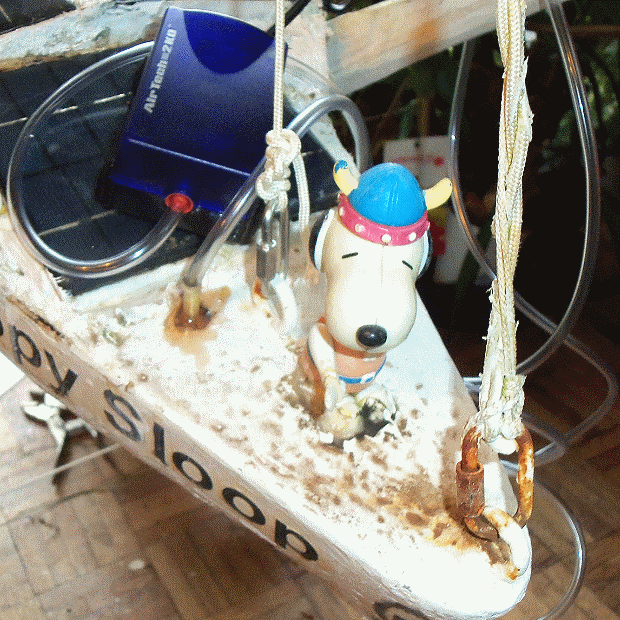 Monday 25th April:
Yes, I just checked the
Microtransat Team-Joker Page
and I see we declared Snoopy Sloop 10 as 15.5 kg. I just weighed Boat 10 : 15.9 kg, and water is still dripping out.
So far we've drained 0.16L = 0.16kg, so our boat 10 weighed over 16 kg ! 4 times
Boat 12's 4kg.
Boat 11 is 11kg. We built is as light as we could. The many Atlantic Attempts with Boat 10,
sometimes needing repairs, means this has crept up in weight over recent years.
Monday 25th April:
Yes, I just checked the
Microtransat Team-Joker Page
and I see we declared Snoopy Sloop 10 as 15.5 kg. I just weighed Boat 10 : 15.9 kg, and water is still dripping out.
So far we've drained 0.16L = 0.16kg, so our boat 10 weighed over 16 kg ! 4 times
Boat 12's 4kg.
Boat 11 is 11kg. We built is as light as we could. The many Atlantic Attempts with Boat 10,
sometimes needing repairs, means this has crept up in weight over recent years.
My wife June will be delighted to hear that today, I got her a spare air pump, from a pet shop next to Maplins.
The one that blows bubbles in her little aquarium has run OK for years, and will probably be OK for a few more.
However, it's always good to have a spare. When I got home, I realised it might be just the thing to speed up
draining what water remains in Snoopy's Boat 10. Click on the picture on the right to see it better.
I inserted a brass tube near Snoopy to fit the air pipe. The pump runs nice and quiet, should I need to
take a "power nap" occasionally.
Tuesday 26th April:Not much more water dripping out now: maybe 50mL (0.05kg) since yesterday.
Filled the drainage hole with Isopon P40. Also filled what looked like an old rudder post hole !
Painted effected area with the usual International Trilux anti fouling paint - although latest evidence
from
Trans-Atlatic Toy Boats
indicates it may not be needed ! :-)
![]()
Sunday 1st May 2016: THE SPOT TRACKER HAS FAILED ! "Don't Panic Mr Mainwaring !" :-) This could delay Snoopy's Atlantic Attempt
if the faulty SPOT Messenger is not repaired or replaced before we get a suitable "weather window".
One obvious option is to swap in the working
SPOT4 (spare)
Messenger.
But first we need to try and diagnose the problem. If we can't fix SPOT3, at least we might reduce the chance of it happening again.
e.g. replace failing batteries and/or dry out moisture inside the Messenger.

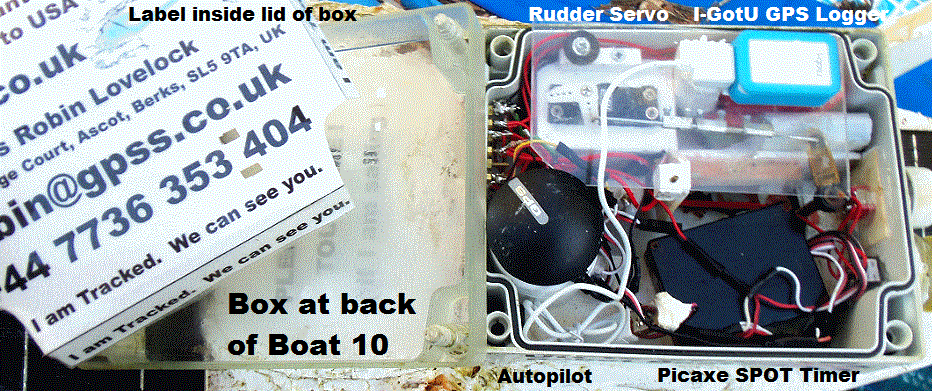
This is a good opportunity to document here the SPOT Trackers that we have used: SPOT Messenger 1 that I refer to as "SPOT1" (lost with Snoopy Sloop 8 in 2012), "SPOT 2" (that developed a similar fault), "SPOT3" (the one now in Boat 10 that has survived many Atlantic Atempts in recent years), SPOT4 (our "first line" spare, under continuous test for years), SPOT5 ( spare, but not yet modified for use with the Picaxe SPOT Timer). We have never used later SPOT Messenger Products, such as Messenger 2 or Messenger 3. The user documentation is in the 2007 SPOT Messenger User Guide. e.g. meaning of green and red flashing LED above [ON/Off] and [OK] buttons.
Last night I noticed that SPOT3 had stopped it's usual reports every 20 minutes, a week ago, on Saturday 23rd April at 1218. Earlier reports were at 0216, 0537, 0557 - a symptom of solar power running low. The Blog entry above, for 23rd April, shows that Boat 10 was moved around, including being brought indoors. Maybe a droplet of condensation water hit a vital part ? Condensation was certainly evident, inside the box lid, the soaked lid label, and some inside the SPOT3 when it was opened. Pressing the [ON/OFF] button to switch off, then back on, resulted in red flashing LED that the User Guide says is a failure of the internal self test.
 SPOT3 was stripped down, and it, with the label, were given
an hour inside our hot boiler cupboard to dry out.
After re-assembly and cooling down, we still got the same bad symptoms, even with different batteries:
After a few seconds from switching on, we get a red flashing LED to indicate that the internal self test has failed.
SPOT3 was stripped down, and it, with the label, were given
an hour inside our hot boiler cupboard to dry out.
After re-assembly and cooling down, we still got the same bad symptoms, even with different batteries:
After a few seconds from switching on, we get a red flashing LED to indicate that the internal self test has failed.
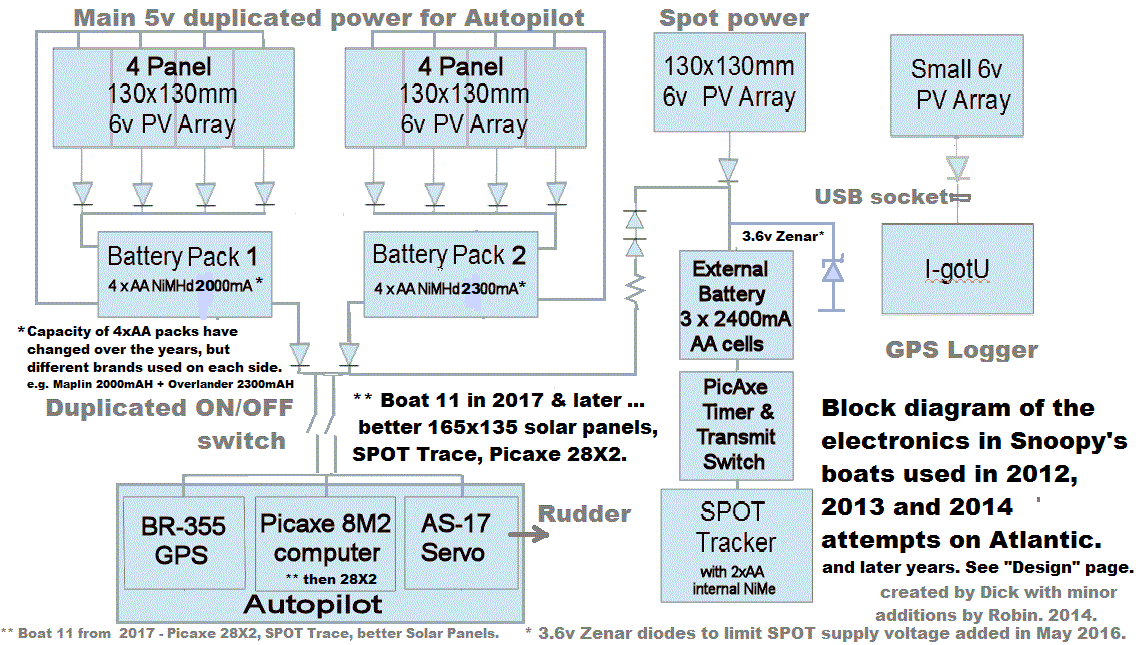 These pictures enlarge if you click on them.
These pictures enlarge if you click on them.
It seems our problem was not protecting the SPOT 3.6v power supply from the single 6v solar panel ! The SPOT 3.6v monitor point gave 4.3v ! No wonder SPOT Messenger, normally getting 3v to 3.6v, did not like it ! Looking at the schematic on the left, from the Design page, it seems there were series diodes to drop voltage between the 5v supply, trickle charging the 3.6v SPOT batteries, but NOT from the dedicated solar panel, able to supply 250mA in bright sunshine. We'd got away from it all these years due to those batteries providing the voltage limitation: 3 AA NiMH and 2 NiMe in parallel. The batteries will be replaced, but we will also provide protection from the solar panel. e.g. 6v - 3.6v = 2.4v/0.7 -> 3 diodes in series, and or 3.6v zenar diodes in parallel to "clamp" the supply. If there is a 3.6v zenar in there, maybe corrosion eventually rotted it away ! With a safer 3.6v SPOT supply, we can then swap in the spare SPOT4 Messenger with more confidence.
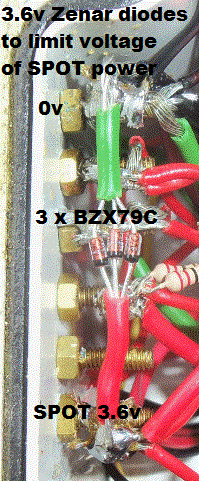 Monday 2nd May:
Three BZX79C 3.6v Zenar diodes, connected in parallel, were added across the SPOT 3.6v supply. Each is rated at 0.14A,
so they should cope with 0.42A and provide redundancy. The three NiMH AA 3.6v pack was replaced, and two NiMe inside
SPOT4 were given a few minutes on the charger, to balance voltages, before bringing them all together: 3.55v.
Monday 2nd May:
Three BZX79C 3.6v Zenar diodes, connected in parallel, were added across the SPOT 3.6v supply. Each is rated at 0.14A,
so they should cope with 0.42A and provide redundancy. The three NiMH AA 3.6v pack was replaced, and two NiMe inside
SPOT4 were given a few minutes on the charger, to balance voltages, before bringing them all together: 3.55v.
I then found this extremely relevant footnote on the Design page: Footnote in May 2014: the blog records minor changes to the SPOT power supply during the rebuild of boat 9 to make boat 10. A single 3 cell NiMHd battery (3.6v) is clamped with 3.7v zenar diodes, and connects into the SPOT internal supply. The NiMHd battery is charged from a single 6v 250mA solar panel at the front of the boat, and also from the main 5v supply, via a series 11 ohm resistor, and two diodes to drop 1.4 volts.
 i.e. two years ago, zenar diodes were added, but 3.7v instead of 3.6v. There is no trace of the zenar diodes
in the box now. The blogs may show when I failed to replace them, during repairs after our previous Atlantic Attemps.
It seems unlikely that they escaped from the box onto the Isle of Wight, Portland Bill, or Brighton :-)
i.e. two years ago, zenar diodes were added, but 3.7v instead of 3.6v. There is no trace of the zenar diodes
in the box now. The blogs may show when I failed to replace them, during repairs after our previous Atlantic Attemps.
It seems unlikely that they escaped from the box onto the Isle of Wight, Portland Bill, or Brighton :-)
SPOT4 was soldered in place, to replace SPOT3, and Boat 10 box contents put back in their normal place.
The boat was put back into the back garden to see how the SPOT 3.6v power, Picaxe timer, and
SPOT4
behave. SPOT Power with Autopilot on and bright: 3.49v@1310; 3.66v@1350; 3.69v@1410; 3.62v@1730.
Autopilot now off and cloudy. When Autopilot is off, there is no trickle supply from 5v power: only from the solar panel
dedicated to SPOT.
SPOT4 reports OK every 20 minutes from 1317, 1337, 1357, etc.
The
Snoopy page was updated so that the SPOT Map points to SPOT4 instead of SPOT3.
Thursday 5th May:
The trickle charging of 3.6v power from the 5v supply was corrected to come from BEFORE the 5v on/off switch,
instead of AFTER. This complies with our old block diagram above. More importantly: it is important to have
a few days, while we have good sunshine, to thoroughly test our 3.6v over voltage protection.
This was reinforced by Terry pointing out that Zenars vary by 10% in their voltage, so the lowest
will attempt to pull all the load. In the longer term, we can look for higher rated Zenars,
or other means of over voltage protection. So far, with only the dedicated solar panel topping up
the SPOT 3.6v supply, the voltage drops overnight so that the SPOT reporting slows from 3/hour to typically 2/hour.
This change may fix that. SPOT Power was 3.57v@1040 in strong sun, with all panels exposed. 3.70v@1100.
Sunday 8th May:
The SPOT 3.6v supply worked well during sunny days: not rising above 3.73v, and sending 3 reports / hour all night. SPOT fixed !
"Well Done Jones !" :-)
Thursday 7th July:
SPOT4 has been OK for months. Tested Autopilot, with Roy looking over my shoulder: re-soldered wire that had come off. That'll Do :-)
![]()
Other "work" currently in progress is in the "experimental" category, for future boats, and so is at the end of
BlogX or the
Boat12 page.
Snoopy (boat 10) remains at home in Sunninghill, ready for the Atlantic attempt, probably in May or June,
depending on availability of our "launch team" and - of course - the required "weather window",
and the repaired SPOT system working OK.
You can read details on
Snoopy's October 2016 Atlantic Attempt.
See "BlogX", describing background experimental work from 2008 until now.
See
Recce,
Compass
and
Software pages.
Play the
July 2014 video of Snoopy's Robot Boat Race to see how well
Snoopy's 2014 boat 10 did against the smaller experimental boat 6.
© 1991-2016 Robin Lovelock. Please credit www.gpss.co.uk if you use material from any of these pages. Thankyou.
![]()
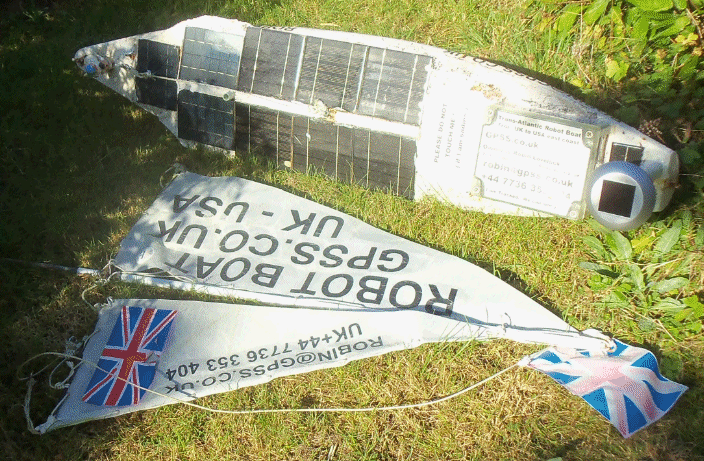 Monday 3rd October 2016:
It seems we have at last got a suitable weather window !
Snoopy was put into a sunnier position, to give his solar battery power a boost: 5.31v,5.27v->5.05v @1320, after autopilot
switched on for over an hour. SPOT4 power was 3.65v with regular reports every 20 minutes.
The I-GotU GPS Logger was reset, and device settings set to every 12 minutes, circular logging.
Same was done for the spare I-GotU. Things like life-jacket, wellingtons and pole put into the car, ready for later in the week.
Monday 3rd October 2016:
It seems we have at last got a suitable weather window !
Snoopy was put into a sunnier position, to give his solar battery power a boost: 5.31v,5.27v->5.05v @1320, after autopilot
switched on for over an hour. SPOT4 power was 3.65v with regular reports every 20 minutes.
The I-GotU GPS Logger was reset, and device settings set to every 12 minutes, circular logging.
Same was done for the spare I-GotU. Things like life-jacket, wellingtons and pole put into the car, ready for later in the week.
Wednesday 5th October 2016:
Clear silicon sealant was smeared over some open cracks, and grease put where rudder post enters hull. Mast/Sails
removed and the boat laid in the sun, to get a boost of solar power.
Snoopy was put in the back of the car, ready for tomorrow's journey to the coast - and the Atlantic ! :-)
![]()

Other stuff ...
Snoopy's Bray Lake Test ... sail 530 metres automatically, through 5 waypoints ...
